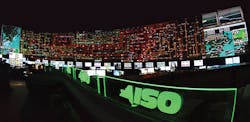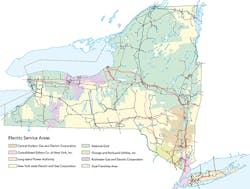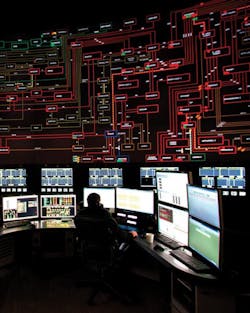NYISO Opens New Power Control Center
Evolution. Collaboration. Innovation. These three words underscore the New York Independent System Operator’s (NYISO’s) commitment to the reliability of New York state’s bulk electricity grid and the efficiency of its wholesale markets. And in the new advanced power control center the NYISO has constructed, those words can be seen in action. The US$38 million, 64,000-sq-ft (5,946-sq-m) secure facility is located near Albany, New York, U.S. Here, operators work around the clock in 12-hour shifts to monitor and balance the supply and demand for power throughout the state.
Video Monitoring
Reliable operation of the grid requires constant vigilance — balancing the supply of power with consumer demand for electricity on a moment-to-moment basis, every hour of the day, every day of the year. The NYISO’s control center enables the ISO to use the latest control technologies and state-of-the-art displays, improving its operators’ ability to receive, process and monitor changing conditions throughout the region.
The centerpiece of the NYISO’s control center is its massive video wall, the largest such utility installation in North America. At 2,300 sq ft (214 sq m), the wall displays a digital representation of the state’s electric grid and provides more than 3,000 live status points that offer NYISO staff vital system operations data, including line flows, line limits, transformer loading, voltages and generator output. System conditions are relayed at 6-sec intervals to the control center. Backup systems provide seamless switch-over capabilities in less than a second, ensuring 24/7 reliability.
Operational Status
The new facility’s digital monitoring technologies support enhanced grid reliability and security by giving NYISO personnel real-time operational status of generation facilities and major transmission lines across the state as well as conditions in neighboring states. The center has been designated critical energy infrastructure by the federal government, highlighting the site’s importance to maintaining the regional power supply.
Regional electric system information, weather and lightning-strike data, power demand forecasts and other information also can be customized for display to assist operators in forecasting and mitigating potential system disturbances.
By being able to more effectively control the supply of power to meet different levels of demand throughout the region and more closely monitor system conditions, the NYISO’s new control center will further enhance the efficiency of wholesale electricity markets. For example, renewable energy is more economically handled by effectively managing wind forecasts, meteorological conditions and production. As New York seeks to meet the targets of its renewable portfolio standard, the control center’s digital platform will continue to deploy evolving renewable resource management tools.
Grand Opening
At a ceremony marking the opening of the NYISO’s new facility, Federal Energy Regulatory Commission Acting Chair Cheryl A. LaFleur recounted the journey from grid operators using lightbulbs plugged into the board for monitoring the flow of electricity to the advanced capabilities of the NYISO’s new control center. “The operators who sat in that control center and the operators who sit in this control center really have the same job, which is to keep the lights on,” she said. “Hospitals and universities, stock exchanges and baseball stadiums, offices and homes, they all depend on electricity. They deserve the best, and they have it here.”
New York State Public Service Commission Chair Audrey Zibelman also noted the new control center’s enhanced capabilities during the grand opening ceremonies. “Being able to monitor and respond in real time to the increasing complexity of the system will be essential if we’re going to meet our goals of having a system that is reliable, resilient and affordable.”
The new facility replaces the organization’s previous 44-year-old control center, which was built by the NYISO’s predecessor, the New York Power Pool. That facility received significant upgrades and now serves as a fully functioning backup control center in compliance with North American Electric Reliability Corporation (NERC) requirements.
The control center also harnesses critical advantages and efficiencies of grid control technologies installed as part of the NYISO’s smart grid project, funded in part by the U.S. Department of Energy. Completed in June 2014, the initiative was conducted in partnership with transmission-owning utilities and power authorities, and involved extensive collaboration among contractors, stakeholders and government agencies.
PMU Deployment
The project successfully deployed phasor measurement units (PMUs) throughout the state. PMUs provide sub-second transmission of information to improve grid operators’ ability to more quickly detect irregularities, predict problems and take corrective action to maintain reliability. The Smart Grid New York PMU network project also included installation of capacitor banks to improve transmission system efficiency by reducing line losses.
These technologies coupled with the new control center allow broader regional collaboration initiatives and a range of innovative opportunities not available previously. This includes better visibility into neighboring states and the ability for the ISO to see situations unfold as they occur.
The 2003 Northeast blackout, which began with a downed power line in Ohio, spread to affect 55 million people across eight states and Ontario, Canada. At that time, grid operators in New York only had a few seconds to respond. With the real-time monitoring technologies featured in the new control center, the ISO is better equipped to mitigate the massive cascading impacts of such outages.
In collaboration with neighboring grid operators, the NYISO is working to connect the upgraded sensor networks to others in New England, the mid-Atlantic, the Midwest and Canada as part of the broader Eastern Interconnection. The goal is to avoid future disruptions like the 1965 and 2003 Northeastern blackouts, whose impacts could have been greatly reduced if today’s grid-monitoring tools had been available.
Data Sharing
With big-data management playing an increasingly important role in ensuring regional grid reliability, the NYISO’s control center also is expected to be vital to the goals of a group of eastern U.S. and Canadian grid operators. The Eastern Interconnect Data Sharing Network (EIDSN) was recently established to manage the North American Electric Reliability Corporation’s NERCnet, the existing data-sharing network used by North American bulk power operators. NERC is the not-for-profit organization responsible for ensuring the reliability of the bulk power system throughout the U.S. and Canada.
In addition to managing the existing network, EIDSN also has been tasked with developing a new, more efficient and effective communications network for sharing data — including information from advanced synchrophasors, like the ones installed in New York state, and other smart grid equipment —to increase the reliability of the Eastern and Québec interconnections.
Technology Evolution
There never has been a more exciting time to work in the electric energy industry. The industry stands on the cusp of a major evolution in how the grid operates as advanced technology and new resources help to enable response to changes in real time and boost operations efficiency. New York, where Edison’s Pearl Street Station created the modern electric grid in 1882, has a legacy of leadership in electricity. The NYISO continues that role through its advanced control center and the opportunities it will foster.
Stephen G. Whitley ([email protected]) is president and CEO of the New York Independent System Operator. He is a veteran of the energy industry with extensive experience in bulk power system planning and operations. Prior to joining the NYISO in July 2008, he served for seven years as senior vice president and COO of ISO New England. He had previously completed a 30-year career with the Tennessee Valley Authority, where he last served as general manager of electric system operations.
Mentioned in this article:
Eastern Interconnect Data Sharing Network Inc. | eidsn.org
Federal Energy Regulatory Commission | www.ferc.gov
New York Independent System Operator | www.nyiso.com
North American Reliability Corporation | www.nerc.com
Video Wall Sharpens System Vision
The New York Independent System Operator control center’s video wall is the largest installation in the North American utility industry with the following specs:
- One hundred 80-inch (2,032-mm) diagonal light-emitting diode (LED) screens are stacked 25 wide by 4 high, spanning a space of 131.5 ft (40 m) wide and 18.3 ft (5.6 m) tall.
- At nearly 2,300 sq ft (214 sq m), the new control center’s video wall is more than 1,000 sq ft (93 sq m) larger than the big board at the NYISO’s previous facility.
- The video wall displays 147 megapixels and is driven by servers capable of running live-motion high-definition video.
The center section of screens features the electric system topology of the New York Control Area (NYCA), providing more than 3,000 live status points displaying line flows, line limits, transformer loading, voltages and generator output among others.
In addition to the center display, the video wall includes two bordering screen arrays with customizable displays that include radar weather maps, graphics illustrating forecast and actual wind generation, wind project location and real-time generation, zonal wholesale energy prices in New York and neighboring control areas, natural gas pipelines, phasor measurement unit data, NYCA load data, and a situational awareness for North American Reliability Corporation reliability (SAFNR) data map.
Sidebar: Advanced Technology Addresses Key Goals
The capabilities of the new control center equip the New York Independent System Operator (NYISO) to better address its goals:
- Enhance situational awareness in system operations, employing greater volumes of data — delivered faster than ever — thanks to technology such as the synchrophasors installed as part of the NYISO’s phasor measurement unit network.
- Implement broader regional markets to mend seams between wholesale electricity markets, enhance the use of existing resources and reduce costs for power consumers.
- Improve integration of renewable energy by expanding the grid operator’s ability to meet the challenges posed by the variability of wind, solar and other renewable resources.







